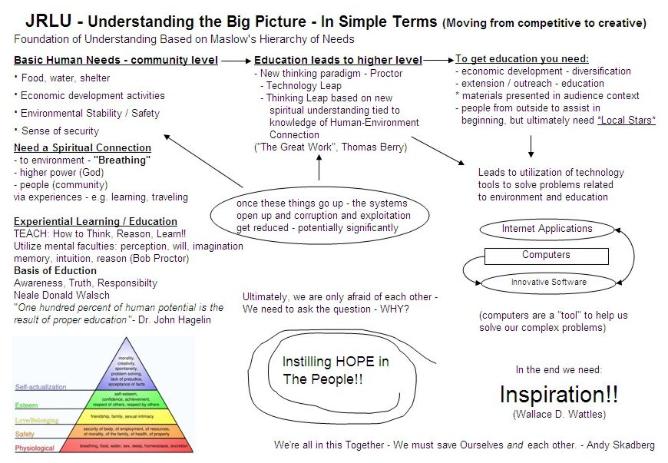Conclusion: The Big Picture a Contextual Summary
As a conclusion to this extensive discussion we introduce a concept that we call “The Big Picture”. This idea developed as a result of about twenty-two years of various “concepts” related to people, community, spiritual connections, the environment, education and technology. In the 1980’s Dr. Skadberg was introduced to Maslow’s Heirarchy of Needs, which we believe to be an important contribution to our understanding of humans and the various stages of development.
We believe that Maslow’s model as a conceptual foundation is a good start, however, over the years we think there are some ways that it may be adjusted. It is not the point here to go into a lengthy discourse, however, we would like to introduce these ideas as possibilities to the reader. The first is that in our personal experience, and our observation of people, that there are opportunities to catalyze individual evolution. The term fairly commonly used for this would be “spiritual awakening”. We believe there are increasing potentialities to raise people out of the lower levels of the Maslow’s pyramid and allow them to experience dramatic transformations. Our approaches, especially related to empowerment will readily embrace these possibilities, although we understand in scientific circles these ideas are difficult to support, they do not readily fit in the “scientific mind-set”. We however will remain open to those possibilities because in a very real sense, we think that real empowerment, and a wholesale transformation of human life on earth is going to require the introduction of influences that fall way outside the paradigmatic realm of “modern” science.
A second point relates to this idea adapted to collective experience. We are recognizing as a real possibility that we may be able to stimulate with our JRLU/RRES, a paradigmatic shift for the communities that we work with. To use another phrase would be a “technology leap”. Our hope is that as we take the lessons that we have learned from our work in the United States, which some would suggest had “advanced” ahead of developing places, that the lessons learned, especially in regards to mistakes, could be avoided.
A specific example is when we were working in Colombia S.A. One of our team was originally from Colombia but spent most of his career in the U.S.* He stated on a number of occasions that the U.S. is twenty years ahead of Colombia. I would argue that those twenty years are not necessarily all in positive ways. In fact, regarding food and agriculture and other systems, I believe developments have become more and more problematic. Many examples could be provided. The point here is the hope that we might be able to take the lessons learned, mistakes and/or successes from one place (United States), and help another place avoid the same problems, or implement the successes, and vice versa. This potentially could even contribute to, or stimulate, a paradigm shift and/or a technology leap, in essence advancing that place and its people ahead twenty years of potential trials and tribulations. We see this happening in numerous places around the globe, so this is not just a “pipe dream”.

Diagram 16: The Big Picture – In Simple Terms
Diagram 16 moves conceptually from the upper left to right to depict those factors that are needed to move people and communities forward through education. Each arrow in the diagram indicates movement and connection, but also identifying critical factors for evolution. Critical ideas regarding connection to the environment, spiritual connections and the potential for dramatic spiritual or personal transformation are also included. The flow of the diagram points to what we believe the bottom line to be – individual transformation (inspiration, empowerment). Also introduced is the ultimate role that technologies can serve as a means to expand communications, and the application towards managing and addressing the pressing problems that humanity faces.
The foundation of this diagram can be captured in the quote from John Hagelin “One hundred percent of human potential is the result of proper education”. To that end, ideas that have been put forward by various people are also included in the diagram as contributing to the idea of advanced, “out-of-the-box” thinking which will be necessary if we hope to create new paradigms of existence. Such authors and inspirational leaders such as Thomas Berry, Bob Proctor, Eckhart Tolle, Ken Carey, Miguel Ruiz and Neale Donald Walsch and many others have introduced concepts specifically about our human capacities and foci that our education should take, in addition to our relationship to the earth, our home.
All of these concepts lead toward what we hope to be a better life for everyone—shouldn´t that be the ultimate goal? An idea that I would introduce here has come from a life of experience and self searching: and that is the idea that I really am my own savior, but, in order to be aligned with Love, once I have realized my own blessed life, that it is my duty and responsibility to make the same available to others. That, in a nutshell, is the ultimate purpose of the JRLU/RRES. To take the various experiences and things that we have learned and share them with others in hopes to provide to them the same opportunities and blessings that we have received so abundantly.
* (Guillermo Rodriguez spent 42 years in the U.S. He studied at Rockford, Il and created a multi-million dollar company bleaching bees wax. Guillermo passed on June 19, 2009 in Andy Skadberg's arms while presenting to a mayor in a Colombian town. We wish all the best to Guillermo, and dedicate our work to his dream to make a difference).
All rights reserved GBCI, SMI & JRLU Team © 2010